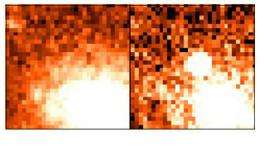Better Supernovae Measurements Aim To Improve Understanding of Dark Energy

(�鶹��ԺOrg.com) -- A new technique for measuring the distances to supernovae more accurately than ever before has been developed by a team of scientists from Yale University, Lawrence Berkeley National Laboratory and a consortium of French laboratories.
Type Ia supernovae are exploding stars that made the discovery of dark energy possible in 1998. Astronomers continue to use supernovae to understand the acceleration of the universe’s expansion. In recent years, astronomers have only been able to measure the distances to these “standard candles” to within about 10 percent accuracy, and as such, can only test current models of dark energy to within a certain limit.
These supernovae are so bright that we can see them even when they are billions of light years away. Because supernovae all have roughly the same inherent brightness, astronomers compare this with how bright they appear to be from here on Earth to determine how far away they actually are. Differences in any given star’s composition, however, mean it can be slightly brighter or dimmer when it explodes, which has made extremely precise measurements of their distances difficult.
The team began looking for supernovae several years ago with the creation of the Nearby Supernovae Factory, the largest supernovae survey ever conducted. To find the supernovae, the team uses QUEST, the world’s largest optical camera, which was designed and developed at Yale. They have discovered 185 nearby supernovae to date, out of which 58 were analyzed for the current study.
“Measuring the distance to supernovae has been a major problem in astronomy ever since the discovery of dark energy,” said Charles Baltay, Yale’s Eugene Higgins Professor of �鶹��Ժics, and one of the paper’s authors. “To understand how dark energy behaved in the early universe, we needed to make more precise measurements.”
Now the team has discovered a way to measure the distances to these supernovae more precisely than ever before, as reported in the forthcoming issue of the journal Astronomy & Astrophysics. Using a telescope in Hawaii to analyze the supernovae’s light signatures, they looked at each star’s individual composition. Providing a custom analysis of its inherent brightness, they were able to determine its distance to better than six percent accuracy.
Next, the team hopes to continue analysis on the remaining nearby supernovae so that they can ultimately test predictions about the history of dark energy and its behavior in the early universe.
“The excitement of science is not knowing what you’re going to find,” Baltay said. “But it’s nice that this first set of supernovae has already proved useful.”
Other members of the Yale team include David Rabinowitz, Richard Scalzo and Will Emmet.
More information: DOI:
Provided by Yale University ( : )
















